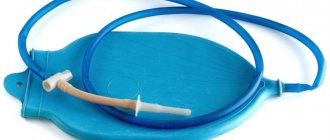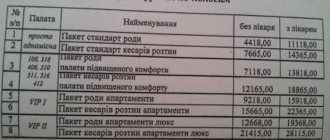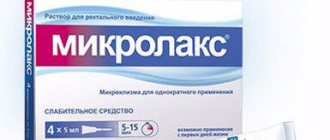Young women preparing to give birth to their first child are often very frightened by their mothers' stories about how childbirth takes place in the maternity hospital. During the period of preparation for childbirth, many expectant mothers learn about the birth process details that they did not think about before pregnancy. Indeed, childbirth is a complex, difficult process and it does not happen at all as it is shown in the movies or depicted in beautiful photographs from the Internet.
One of the procedures that greatly confuses expectant mothers is the enema, which is given to a woman with contractions upon admission to the maternity hospital. It must be admitted that not everyone currently goes through this procedure, but below we will explain why an enema before childbirth is a really necessary, although not very pleasant, procedure.
How is an enema done before childbirth?
The procedure for cleansing the intestines before childbirth does not take much time. In order to give a woman in labor an enema, she is placed on the couch on her side. The tip of the vessel is inserted into the anus to administer an enema. The liquid enters the intestines in a couple of minutes and immediately after this you need to go to the toilet and allow the liquid to leave the intestines.
The procedure does not cause pain, but it may be unpleasant. To minimize the risk of embarrassment, stick to the following plan:
- Find out in advance where the toilet is located;
- relax at the moment when the liquid enters the intestines, this will speed up the procedure;
- be prepared to tense your anus at the moment when the tip is removed from the anus, so that the contents of the intestines do not leave the body prematurely;
- don’t panic, the enema doesn’t contain as much water as it might seem;
- Once you are in the toilet, do not rush to leave the toilet; the water may take longer to leave the intestines.
Does everyone get an enema?
How to understand that the stomach has dropped before childbirth?
A woman may experience discomfort in the pubic bone area. They appear due to the fact that the descending fetus puts pressure on the organs located in the pelvic area
Not all women undergo an enema before childbirth. There may be several reasons for this:
- the method of obstetric care in a particular maternity hospital may not include a mandatory enema before childbirth;
- late arrival of a woman in labor at the maternity hospital, when the baby is ready to be born and there is no time for an enema;
- rapid labor, in which the birth process develops very quickly and there is no time left for hygiene procedures;
- if there are complications during childbirth or contraindications to performing an enema.
Why do an enema before childbirth?
A woman preparing to become a mother for the first time may think that an enema before childbirth is a humiliating whim of doctors. However, it is not. An intestine filled with feces significantly complicates pushing and moving the baby through the birth canal.
In addition, the expectant mother should know that during the pushing and exit of the baby, feces will also involuntarily leave the body. During childbirth, a woman may not feel this. Many women empty their bowels and bladder directly into the hands of doctors without even noticing it. Needless to say, it is better to do an enema in advance than to experience such embarrassment.
10 reasons that can cause rapid labor
If you are pregnant, you have probably already heard a lot of stories about how a neighbor (a friend’s aunt or a colleague’s mother) gave birth before the ambulance arrived for them.
Not all obstetricians and gynecologists share the opinion that it is mandatory to perform an enema before childbirth. Modern research shows that in some cases, artificial bowel movement does not lead to easier delivery. This issue can be discussed with the doctor monitoring the pregnancy.
Do you do an enema before a caesarean section?
Before a planned cesarean section, the woman in labor is also given an enema. This minimizes the risk of infection during surgery and makes postpartum recovery easier.
Surgical delivery, planned or emergency, always involves a large incision in the abdominal muscles. For several days after surgery, even with good pain relief, abdominal muscle tension will be painful. Therefore, pre-cleaned intestines and the absence of the need to “walk around” immediately after surgery make the postoperative period less painful.
There is another benefit to an enema before a natural birth or cesarean section: often after delivery, a woman’s intestines begin to become “lazy” and not everyone can have a bowel movement in the first days after birth. At the same time, the presence of stagnant feces in the intestines provokes bloating, inflammation and other complications.
Is it possible to do an enema at home?
It is probably much easier to do an enema at home. At home, the procedure does not seem so humiliating, so it is much easier to bear. If you decide to do an enema at home, then you need to start the procedure when the woman is sure that she is having real contractions. In this regard, it is necessary to be able to distinguish the real onset of labor from false contractions, which often occur closer to the 40th week of pregnancy.
Remember that it is strictly forbidden to give an enema if pushing has already begun or there are contraindications.
It is very difficult to do an enema alone, and with a pregnant belly it becomes almost unattainable. So it is necessary to think in advance who can help the pregnant woman at this moment and discuss with the assistant the procedure for carrying out the procedure. And, of course, you need to agree with your family that no one will occupy the toilet while you are having an enema.
So, to cleanse the intestines, you should lay a waterproof diaper or oilcloth on the bed or sofa. This, of course, does not mean that the intestines will empty right on the bed, but in order to avoid misunderstandings, it is better to protect yourself and the upholstered furniture in the house.
A liter of clean boiled water is poured into a special rubber vessel for enemas, called an Esmarch mug, or a heating pad with a special nozzle. The water temperature should not be too high or low, but should be approximately equal to body temperature, that is, 37 degrees. Both hot and cold enema can cause unwanted complications in the birth process.
After the water is poured, a hose and a nozzle for rectal administration are attached to the vessel. In order to make the procedure painless, the nozzle and the anus should be lubricated with olive oil or Vaseline.
During an enema at home, a woman can choose 2 positions:
- lying on your side with your knees bent to your chest;
- standing in a knee-elbow position so that the buttocks are slightly higher than the shoulders.
The assistant clamps the tip of the hose with his finger and lifts the vessel with liquid to a height of about a meter relative to the woman’s body. You can hold it in your hands or hang it somewhere. After that, the tip is carefully inserted into the woman’s anus. This should not cause any pain, otherwise the procedure should be stopped immediately.
As the fluid from the vessel enters the intestines, a feeling of pressure will increase in the abdomen. Immediately after the procedure is over, you need to carefully get up, go to the toilet and empty your bowels. If after the enema there is a feeling that the intestines are still full, then the procedure can be repeated one more time after 30-40 minutes.
Upon arrival at the maternity hospital in the emergency department, you should immediately warn the receiving nurse that the woman in labor has already had an enema.
An enema is an unpleasant procedure, but before a cesarean section, and sometimes after it, it is absolutely necessary. For women in labor who are admitted to the maternity hospital for a natural birth, this procedure is done in the emergency department. Before surgical delivery, it is carried out several hours before the start of the operation.
Many women believe that an enema during childbirth is needed so that when pushing, the woman does not empty her intestines at the same time. But then the question arises: why flush the intestines before surgery, since the woman is not pushing? We will talk about how and why an enema is done before surgical delivery in this article.
Day "X"
The nurse will wake you up in the morning for the enema. Then they will bandage your legs to the knees with an elastic bandage (you need to purchase it in advance, one 3-4 meter is enough, they will simply cut it in half). This is necessary because the blood flow of the lower extremities is disrupted, and to prevent damage to the veins, you need to wrap your legs. The bandages can be removed as soon as you get out of bed.
You should not drink water before surgery! So you'll have to be patient.
At the appointed time, you go to the operating room with a bag of things. The nurse will help you put on a sterile shirt, cap, and shoe covers. The anesthesiologist will give an injection in the back, after which the legs gradually begin to go numb. Therefore, you need to lie down quickly while you are able to do it yourself. The next step is to insert a urinary catheter, this is no longer painful, because... painkiller works. On the table, the incision site will be treated with alcohol and iodine. They will hang a curtain in front of your face so that you cannot see anything. An IV will be connected to your right arm, and a blood pressure cuff will be placed on your left arm. He will be monitored throughout the operation. The doctor makes a test incision, and if there is no sensitivity, the operation can be considered to have begun.
During the operation, the only moment associated with painful sensations is the process of delivering the child. But this is tolerable and is rewarded by the baby’s first dissatisfied cry. You will hear it approximately 10 minutes after the start of the operation. They will show you the child and take him away for processing. All. All you have to do is wait until they clean you up and sew you up (about 30 minutes).
Why is this necessary?
An empty bowel does not put pressure on the uterus. And this is the main reason why an enema is given before the operation. The uterus should be free, this will allow the surgeon to perform the operation itself more efficiently and minimize the risks of possible infection that exist with every surgical intervention. An empty intestine will also help a woman in the period after the operation, when the uterus begins to contract and involute.
Women who have undergone similar or other abdominal surgery know well how painful and scary it can be to go to the toilet, laugh, and cough after it. Preliminary cleansing of the intestines is a guarantee that the woman will not want to go to the toilet during the first three days after childbirth, and she will not have to suffer herself and put the fresh internal and external sutures at risk of tearing.
After the operation, the woman is prescribed a strict diet, which is also aimed at preventing the intestines from becoming full and putting pressure on the uterus from the intestinal loops due to constipation. This is the key to proper and successful recovery.
The fear of pushing after surgery can be so strong that a woman psychologically cannot overcome it even 4-6 days after the operation.
In this case, an enema will help empty the intestines and cleanse the body. However, in the postoperative period, doctors recommend using pharmaceutical microenemas or rectal suppositories with a laxative effect.
Recommendations for a pregnant woman on the eve of a cesarean section
After the operation you must:
- the first attempts to sit down and stand up should be made 4-6 hours after surgery to reduce the risk of complications;
- try to walk more, despite the nagging pain in the lower abdomen;
- maintain hygiene;
- do not lift anything heavier than the child’s weight;
- do not remove the bandage for 1-2 months after birth;
- periodically open the seam to allow air to enter.
Paying attention to your own health will help you recover faster.
Nutrition
The last meal before surgery should occur no later than 8 hours before it.
Avoid fried, salty and spicy foods. You should not indulge in high-calorie foods - chocolate, pastries, sweet carbonated drinks, packaged juices.
Tea and coffee are also prohibited. Caffeine and tinin have a tonic effect and stimulate the nervous system.
How is it done?
It is customary to give an enema early in the morning on the day of a planned operation. The woman will be raised early, before the general rise, specifically in order to cleanse the intestines.
The pregnant woman is placed on her side on the couch, the tip is lubricated with Vaseline or baby cream and inserted into the anus. After this, the nurse holds Esmarch's mug and monitors the filling of the intestines with warm water. The water must be warm (at least 20 degrees). Cold weather can cause involuntary vasospasm, which can negatively affect the condition of the expectant mother and her baby.
Esmarch's mug, connected to the tip by a flexible connecting tube about one and a half meters long, should contain from one and a half to two liters of water.
Ideally, you need to pour everything into the intestines, but in practice, a smaller amount is usually administered, since when the intestines are filled with water, a feeling of distension occurs, which can be not only difficult for a pregnant woman to endure, but also quite painful.
After filling the intestines with water, the nurse helps the pregnant woman to the toilet, where she can empty her intestines. After the enema, you should definitely wash yourself well with soap and shave your pubic area. After the enema, you cannot eat, because the woman will have to be given anesthesia.
An enema is given once before surgical childbirth .
Preparing for a planned caesarean section
Since elective surgeries are usually performed in the morning or afternoon, the patient should take a hygienic shower the night before and remove hair from the intimate area with a razor. Meals should be light. So, for lunch you are allowed to eat only the first course, and for dinner you can drink a glass of kefir or a cup of tea. After 18:00 and in the morning before surgery, the consumption of food and liquid is prohibited. 2 hours before the procedure, all women in labor undergo a cleansing enema. Clothing and personal items are sent to a storage unit. You are allowed to take with you:
- Robe;
- Slippers;
- Mobile phone;
- 2 elastic bandages;
- 1 liter of clean water without gas;
- Sliced lemon.
In addition, preparation for a planned cesarean section includes a conversation with an anesthesiologist. The doctor talks about the types of pain relief and finds out whether the patient has had anesthesia before and whether she has any contraindications to the use of certain drugs. If necessary, to determine the individual dosage of medications, the weight of the woman in labor is specified. Based on the data obtained, the optimal pain relief option is selected. Usually, preference is given to regional (spinal or epidural) anesthesia as the safest for mother and baby. The use of general anesthesia occurs in cases where the use of regional anesthesia is impossible for medical reasons. After this, the woman confirms in writing her consent to the operation and the proposed type of anesthesia.
After surgery – is it necessary?
A cleansing enema in the full sense of the word with an Esmarch mug and an unpleasant rectal tip is usually not given after surgery. It is considered optimal if a woman’s stool is restored naturally within 3-4 days after a cesarean section. But in practice, its independent restoration is very rare.
But intestinal overflow and constipation should not be allowed. That’s why the doctor recommends a laxative. If a woman is allergic to the components of a laxative or she does not want to take risks and take tablets or capsules due to breastfeeding, then rectal suppositories are suitable, for example, Bisacodyl or other drugs that do not have a systemic effect, and therefore will be completely safe for infants .
It is important to know that the systematic use of such drugs causes weakness of intestinal tone, in which it becomes almost impossible to go to the toilet without a laxative. Therefore, women are recommended to use microenemas and suppositories only a limited number of times, and gradually begin to go to the toilet on their own.
Childbirth is a complex process that requires preparation. In some cases, the birth of a child is possible through a caesarean section.
One of the methods of preparation is considered to be artificial bowel cleansing, but the procedure is not always carried out. Expectant mothers may be wondering whether they do an enema before a cesarean section.
Duration of hospitalization and preparation
Sometimes the operation needs to be carried out urgently, and there is no talk of meeting deadlines. During a normal pregnancy, the date of the operation depends on the method of conception (IVF or ICSI), the woman’s hormonal background, age, and the number of expected babies.
When carrying twins or triplets, a planned CS is performed at 38 weeks. The reason is frequent cases of premature birth (in 75% of cases).
A multiple pregnancy is not an absolute indication for surgical intervention, so often a mother carries her babies to term until 40 weeks, or gives birth to one baby on her own, and the second through surgery.
When carrying the first child, they try to bring the CS date as close as possible to the expected date of birth, that is, the operation is performed at 39-40 weeks. A woman can choose her own due date by discussing the doctor’s work schedule.
IVF or ICSI
Previously, after IVF, the CS procedure was mandatory, now more and more women are giving birth naturally. The decision is made by the doctor, taking into account the following factors:
- age of the woman in labor - it is believed that after 35 years the risk of complications during childbirth increases;
- the presence of pathologies: gestosis, fetoplacental insufficiency; chronic diseases;
- duration of infertility;
- number of children being born.
The decision on the need for a CS is made at 37-38 weeks of pregnancy for both IVF and IVF/ICSI.
It is recommended to perform no more than 3 caesarean sections. A scar on the uterus is not a limitation for subsequent pregnancy, but you should refrain from planning a child for at least 2 years. Both conception and termination of pregnancy are prohibited.
There are cases when women underwent 4-5 CS operations without harm to their health, but the risk of complications is higher each time. In each specific case, you should focus on the individual characteristics of the body.
Performing an enema before childbirth
This procedure takes little time, the enema is performed using standard methods.
The pregnant woman lies on her side or gets on all fours, after which the end of the enema is inserted into the anus and the liquid from the vessel is injected into the rectum.
Next, the act of defecation is carried out, and if necessary, the process is repeated. An enema does not cause pain, but it is not a pleasant procedure.
To eliminate discomfort you need to:
- At the moment the liquid enters, relax completely to speed up the entire process.
- Be prepared to squeeze the anus when you need to remove the end of the enema so that emptying does not begin prematurely.
- Do not be afraid of the process, since there is not very much water in the enema, as may be felt during administration.
- For complete release, it is recommended to spend longer time on the toilet.
Not all pregnant women can undergo an enema before giving birth. The main reasons why cleansing is not carried out:
- The method is not used in the maternity hospital, but is mandatory for preparation.
- Emergency birth.
- There are complications or contraindications for performing an enema.
Not all women understand why an enema is used; some pregnant women may think that this is a humiliating procedure.
The main indications are relief of pushing due to the exclusion of feces; in addition, the child can pass out easier during movement, since fecal stones will not interfere with this process.
The necessity can be attributed to psychological reasons, because after cleansing the woman will not think about holding back feces, but will engage in pushing, focusing on childbirth.
Enema before cesarean
If a caesarean section is planned, pregnant women should have an enema. This procedure allows you to minimize infection during surgical delivery, and also speeds up the recovery process after the birth of the child.
Childbirth by cesarean section involves a fairly large abdominal incision, and after the operation the woman may experience severe pain for several days, even if high-quality anesthesia was performed.
An enema before surgical childbirth allows you to completely cleanse the intestines, which eliminates the need for bowel movements after childbirth. Due to this, pain after surgery is reduced.
The benefits of an enema may have other benefits. For example, if constipation occurs, this may be the only method for emptying. Bloating, inflammatory processes and a number of other complications are also excluded.
Planned caesarean section: timing
In most cases, doctors try to bring the day of a planned cesarean section as close as possible to the date of natural labor. Usually the operation occurs at 38-39 weeks of gestation. 8-14 days before the appointed date, the gynecologist leading the pregnancy writes the patient a referral to the maternity hospital, where she needs to undergo an examination, including blood and urine tests, determination of blood group and Rh factor, and a cytological smear. In addition, before the operation, doctors assess the condition of the fetus based on the results of ultrasound (US), cardiotocography (CTG) and Doppler measurements in the vessels of the mother-placenta-fetus functional system.
Enema at home
The cleansing procedure can be carried out directly in the maternity hospital, but it is much easier to perform the operation at home.
It will be psychologically easier for pregnant women. If a decision is made to perform artificial bowel cleansing, then the process must begin when real contractions appear.
To do this, you need to understand how to distinguish between false and real contractions, which actively appear around the 40-week period.
It will be quite difficult for a woman to give an enema on her own, and sometimes it is simply impossible. To avoid difficulties, you need to seek help from family and friends.
For the cleansing procedure, you will need to prepare, buy the enema itself, as well as oilcloth. Cover the sofa or bed with oilcloth and place a diaper on top.
After this, you need to prepare Esmarch’s mug itself and fill its vessel with clean boiled water, the temperature of which will be about 37 degrees.
Too hot or cold liquid can cause negative consequences. In addition to water, you can use decoctions based on herbal ingredients, which can heal wounds and relieve inflammation, but they must be recommended by a doctor.
After filling the container with water, you need to put on a hose and a nozzle that will be inserted into the anus. To avoid pain and discomfort, the end of the enema is lubricated with oil, petroleum jelly or baby cream, and insertion of the end is best done with turns.
To carry out the procedure, a pregnant woman needs to lie on her left side and press her knees to her stomach, but you can get on all fours and lower your shoulders.
After inserting the end into the anus, the assistant raises the vessel with water about a meter above the body and opens the tap to drain the liquid into the intestine.
Water should enter the intestines quite slowly, in small portions. As the woman fills, she will feel fullness and slight pressure.
She needs to try to keep the water inside. When 1.5-2 liters of liquid have been introduced, you need to take out the end of the enema, try to lie down for 5-10 minutes and go to the toilet to empty it.
If after the procedure there is a feeling of full intestines, then the enema is repeated after half an hour. If pain and other unpleasant sensations appear, the process must be stopped.
At the end of the procedure, the water from the intestines should come out clean, without feces. After this, you need to go to the maternity hospital and tell the health workers that the cleansing has already been carried out.
Then the doctor conducts a routine examination, clarifies the necessary information and sends the woman in labor to the ward to prepare for a caesarean section.
Day "X"
The nurse will wake you up in the morning for the enema. Then they will bandage your legs to the knees with an elastic bandage (you need to purchase it in advance, one 3-4 meter is enough, they will simply cut it in half). This is necessary because the blood flow of the lower extremities is disrupted, and to prevent damage to the veins, you need to wrap your legs. The bandages can be removed as soon as you get out of bed.
You should not drink water before surgery! So you'll have to be patient.
At the appointed time, you go to the operating room with a bag of things. The nurse will help you put on a sterile shirt, cap, and shoe covers. The anesthesiologist will give an injection in the back, after which the legs gradually begin to go numb. Therefore, you need to lie down quickly while you are able to do it yourself. The next step is to insert a urinary catheter, this is no longer painful, because... painkiller works. On the table, the incision site will be treated with alcohol and iodine. They will hang a curtain in front of your face so that you cannot see anything. An IV will be connected to your right arm, and a blood pressure cuff will be placed on your left arm. He will be monitored throughout the operation. The doctor makes a test incision, and if there is no sensitivity, the operation can be considered to have begun.
During the operation, the only moment associated with painful sensations is the process of delivering the child. But this is tolerable and is rewarded by the baby’s first dissatisfied cry. You will hear it approximately 10 minutes after the start of the operation. They will show you the child and take him away for processing. All. All you have to do is wait until they clean you up and sew you up (about 30 minutes).











